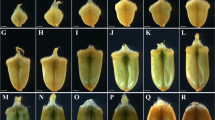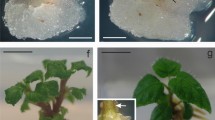Summary
Vigorously growing suspension cultures of ‘normal’, amylose-extender (ae) and waxy (wx) maize endosperm were established from near isogenic lines of maize inbred A636. The recovery of the ability to produce vigorous cultures of ae and wx endosperm by backcrossing demonstrate the genetic control of endosperm growth in vitro. Phenotypic expression of the endosperm mutants in culture was studied by examining the properties of starch accumulated in endosperm cultures and starch from developing and mature kernels of the same genotype. After 9 months in culture, the amylose contents of the starch in normal callus tissue and normal endosperm tissue were not significantly different, 28.2% and 31.7%, respectively. Starch granules from normal cultures and endosperm stained blue-black with iodine and were round to polygonal in shape. The starches of wx endosperm and callus cultures contained no amylose, and wx starch granules stained brown-orange with iodine. Although, wx starch granules were primarily round, a few granules with “jagged edges” were observed in starch samples isolated from cultures and kernels. The percent amylose in starch from ae callus was significantly lower than the amylose content of starch from ae endosperm tissue, 39.9% and 67.7%, respectively. Starch granules from ae endosperm and cultures were smaller than normal and wx starch granules. Irregular starch granules which are typical of ae endosperm were present in ae callus tissue, but were less frequently observed. We conclude that specific endosperm mutant phenotypes are expressed in vitro.
Similar content being viewed by others
References
Boyer CD, Daniels RR, Shannon JC (1977) Starch granule development of several Zea mays L. genotypes affecting kernel polysaccharides. Am J Bot 64:50–56
Boyer CD, Daniels RR, Shannon JC (1976a) Abnormal starch granule formation in Zea mays L. endosperm possessing the amylose-extender mutant. Crop Sci 16:298–301
Boyer CD, Garwood DL, Shannon JC (1976b) The interaction of the amylose-extender and waxy mutants of maize (Zea mays L.). Fine structure of amylose-extender waxy starch. Stärke 28:405–410
Boyer CD, Shannon JC (1974) Chromosome constitution and cell division in in vitro cultures of Zea mays L. endosperm. In Vitro 9:458–462
Boyer CD, Shannon JC, Garwood DL, Creech RG (1976c) Changes in starch granule size and amylose percentage during kernel development in several Zea mays L. genotypes. Cereal Chem 53:327–337
Chu LC, Shannon JC (1975) In vitro cultures of maize endosperm: a model system for studying in vivo starch biosynthesis. Crop Sci 15:814–819
Graebe JE, Novelli GD (1966) A practical method for largescale plant tissue culture. Exp Cell Res 41:509–520
Hodge JE, Hofreiter BT (1972) Determination of the reducing sugars and carbohydrates. In: Whistler RL, Wolfrom ML (eds) Methods in carbohydrate chemistry, Vol 1. Academic Press, New York, p 380
LaRue CD (1949) Cultures of the endosperm of maize. Am J Bot 36:798
Linsmair EM, Skoog F (1965) Organic growth factor requirements to tobacco cultures. Physiol Plant 18:100–127
Shannon JC (1982) Maize endosperm cultures. In: Sheridan W (ed) Maize for biological research. Plant Mol Biol Assoc, Charlottesville Va, pp 397–400
Shannon JC, Batey JW (1973) Inbred and hybrid effects on the establishment of in vitro cultures of Zea mays L. endosperm. Crop Sci 13:491–492
Shannon JC, Garwood DL (1984) Genetics and physiology of starch development. In: Whister RL, BeMiller JN, Paschall EF (eds) Starch: Chemistry and Technology, 2 edn. Academic Press, New York, pp 25–86
Shannon JC, Liu JW (1977) A simplified medium for the growth of maize endosperm tissue in suspension culture. Physiol Plant 40:285–291
Shimamoto K, Ackermann M, Dierks-Ventling C (1983) Expression of zein in longterm endosperm cultures of maize. Plant Physiol 73:915–920
Spurr AR (1969) A low viscosity epoxy resin embedding medium for electron microscopy. J Ultrastruct Res 26: 21–43
Straus J, LaRue CD (1954) Maize endosperm tissue grown in vitro. 1. Culture requirements. Am J Bot 41:687–694
Tabata M, Motoyoshi F (1965) Hereditary control of callus formation in maize endosperm culture in vitro. Jpn J Genet 40:343–355
Tamoaki T, Ullstrup J (1958) Cultivation in vitro of excised endosperm and meristem tissues of corn. Bull Torrey Bot Club 85:268–272
Yeh JY, Garwood DL, Shannon JC (1981) Characterization of starch from maize endosperm mutants. Stärke 33:222–230
Author information
Authors and Affiliations
Additional information
Communicated by P.L. Pfahler
Supported in part by the United States Department of Agriculture Competitive Grant 85-CRCR-1-1740. Contribution No. 94, Department of Horticulture. The Pennsylvania State University. Authorized for publication as paper No. 7373 in the journal series of the Pennsylvania Agricultural Experiment Station
Rights and permissions
About this article
Cite this article
Saravitz, C.H., Boyer, C.D. Starch characteristics in cultures of normal and mutant maize endosperm. Theoret. Appl. Genetics 73, 489–495 (1987). https://doi.org/10.1007/BF00289184
Received:
Accepted:
Issue Date:
DOI: https://doi.org/10.1007/BF00289184




